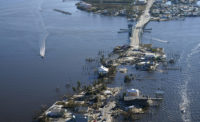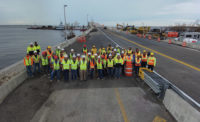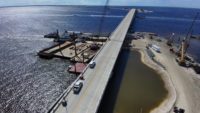Crews are restoring power and clearing roads in the wake of Hurricane Ian, which made landfall in southwest Florida on Sept. 28, causing extensive damage in Fort Myers as well as to the Sanibel Causeway, leaving it impassable. The Category 4 storm washed out roads, caused extensive floods and power outages and damaged buildings.
Florida Gov. Ron DeSantis (R) called the storm a 500-year flooding event, saying in a statement that search and rescue efforts began at 1 a.m. Sept. 29. More than 42,000 line repair workers were on the ground working to restore power to the more than 2 million people still without electricity the day after the storm.
The Florida Dept. of Transportation (FDOT) says most of Interstate 75 is usable with crews working to open the rest. About 100 engineers are performing bridge inspections and 1,200 other workers are conducting cut-and-toss operations.
Jim Yocum, public affairs specialist for the U.S. Army Corps of Engineers, says prepositioned crews were heading out Sept. 29 to start inspecting the Herbert Hoover Dike around Lake Okeechobee and other structures along the Okeechobee Waterway.
“We will begin beach inspections and port surveys when we are able to safely do so and when we won’t be in the way of first responders,” he says.
A video taken via helicopter and posted on the Lee County Sheriff’s Office Facebook page Sept. 29 showed major damage, including large sections of roadways washed out, a building on fire, extensive flooding and wind damage.
Steve Cona, president and CEO of the Florida Gulf Coast chapter of Associated Builders and Contractors (ABC), says the damage in Lee, Collier and Charlotte counties appears devastating, and that would take substantial time, energy and resources to rebuild those communities.
Building Structures Held Up
“Florida building code is one of the best codes in the world, and the structures held up,” Cona says. “The biggest problem is water damage. Not a lot of things can withstand the damage that water causes.”
One area of concern is the way bridges to barrier islands failed, he says. Rebuilding will require substantial amounts of materials, time and labor, all of which are already in critical short supply throughout the state.
ABC’s goal is to work with local officials to streamline the recovery process, whether with permitting or getting resources to those who need them. Cona says he knows many contractors are ready to assist in the effort.
“We don’t know what the damage is going to be until "it’s all said and done,” he says, noting that there are a lot of ongoing projects in southwest Florida, where teams will head over the next 24 to 48 hours to assess damage.
Lee County Hard Hit
Lee County, which includes Cape Coral and Fort Myers, was among the hardest-hit areas, including the barrier island of Cayo Costa, where the storm made its initial landfall.
“We don’t even know exactly what we face just yet,” said Lee County Sheriff Carmine Marceno, in a press conference Sept. 28. “We know we’ve been hit very hard.”
There have been reports of compromised and collapsed buildings, he said, but officials don’t know exactly what damage has been done and at the time, teams could not get into the community until conditions improved.
The storm now moves north, where cities, including Charleston, S.C., are bracing for its arrival. A National Weather Service update Sept. 29 warns of a storm surge through Sept. 30 along the coast—from Florida, Georgia and South Carolina—as it moves to the eastern coast of Florida and travels north.
Hurricane-force winds are expected along the South Carolina coast beginning early Sept. 30, and ongoing major and possibly record river flooding is set to continue across central Florida, while considerable flash and urban flooding is expected.






Post a comment to this article
Report Abusive Comment